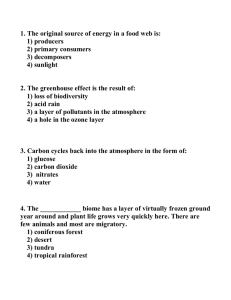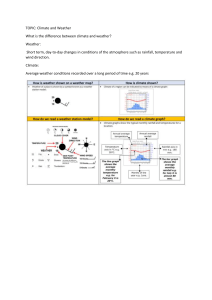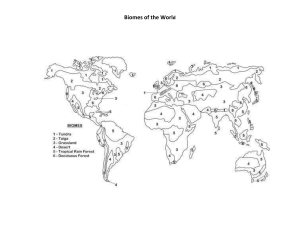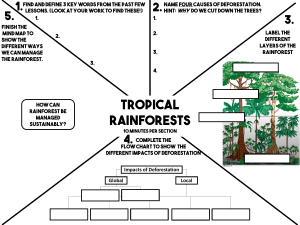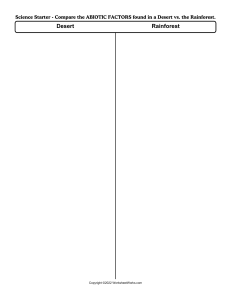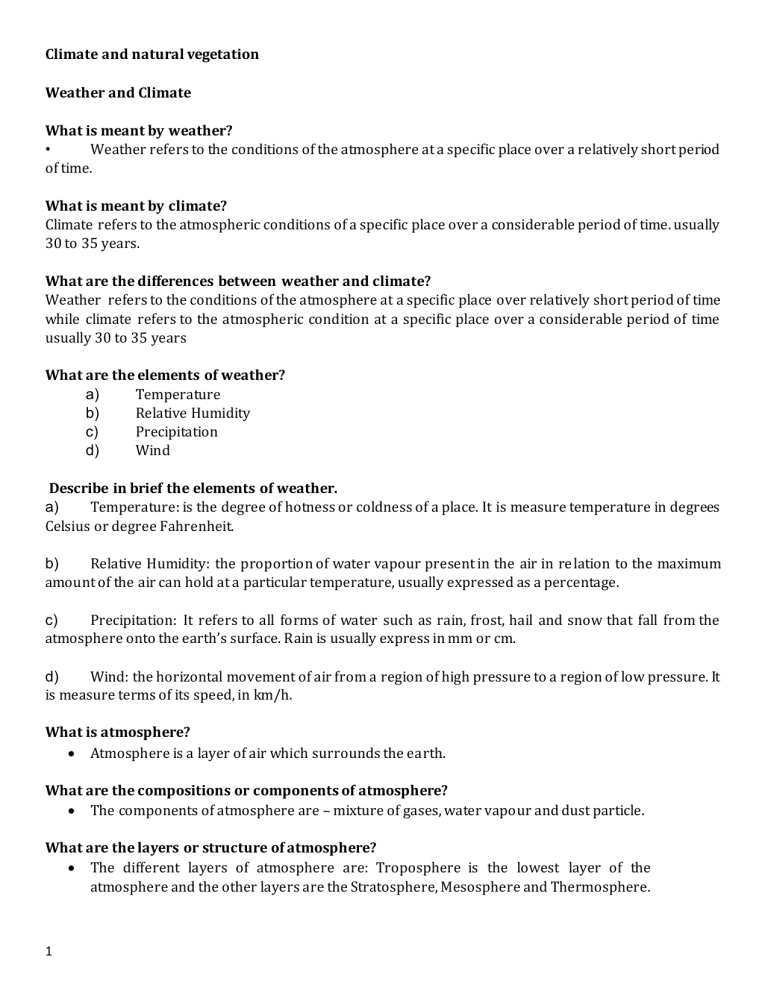
Climate and natural vegetation Weather and Climate What is meant by weather? • Weather refers to the conditions of the atmosphere at a specific place over a relatively short period of time. What is meant by climate? Climate refers to the atmospheric conditions of a specific place over a considerable period of time. usually 30 to 35 years. What are the differences between weather and climate? Weather refers to the conditions of the atmosphere at a specific place over relatively short period of time while climate refers to the atmospheric condition at a specific place over a considerable period of time usually 30 to 35 years What are the elements of weather? a) Temperature b) Relative Humidity c) Precipitation d) Wind Describe in brief the elements of weather. a) Temperature: is the degree of hotness or coldness of a place. It is measure temperature in degrees Celsius or degree Fahrenheit. b) Relative Humidity: the proportion of water vapour present in the air in re lation to the maximum amount of the air can hold at a particular temperature, usually expressed as a percentage. c) Precipitation: It refers to all forms of water such as rain, frost, hail and snow that fall from the atmosphere onto the earth’s surface. Rain is usually express in mm or cm. d) Wind: the horizontal movement of air from a region of high pressure to a region of low pressure. It is measure terms of its speed, in km/h. What is atmosphere? • Atmosphere is a layer of air which surrounds the earth. What are the compositions or components of atmosphere? • The components of atmosphere are – mixture of gases, water vapour and dust particle. What are the layers or structure of atmosphere? • The different layers of atmosphere are: Troposphere is the lowest layer of the atmosphere and the other layers are the Stratosphere, Mesosphere and Thermosphere. 1 Describe the factors that influence the temperature. The factors that influence the temperature are – latitude, altitude, distance from the sea and cloud cover. a) Latitude • Temperature decreases as the latitude increases. • At the equator, the sun’s rays strike the earth’s surface perpendicularly and the solar radiation is concentrated over a smaller areas compared to the Poles, the heat is more intense at the equator. Thus experiences a higher temperature. • As the sun’s rays strike at an angle and the solar radiation is spread over a larger area, Poles experiences a lower temperature than in the equatorial belt. • The sun rays travel longer distance to reach Poles and in the process it loses its heat, and lower the temperature at Poles. b) • • • • c) • • • • • d) • • • Altitude temperature decreases with increasing altitude at the rate of 6.5 0 C per 1000 metres in the troposphere. This rate of decrease is known as the Normal Lapse of Rate. The earth surface has more dense air which absorbs more heat from the sun but the higher altitude has thin air and unable to absorb heat effectively as the dense air. The higher altitude heats up the air through the process of conduction. Distance from the sea the land heats up and cools down more quickly than the sea water. This difference in the rate of heating and cooling of land and sea has an effect on the temperature of coastal areas. During the summer, the land is heated up quickly and experiences a higher temperature on the land. During the winter, the land cool down quickly and experiences a lower temperature than the sea. However, the temperature in the coastal areas almost remains constant due to effect of land and sea breeze. Cloud cover cloud cover affects the temperature of a place by influencing the amount of solar radiation entering and leaving the atmosphere. During the day, when the cloud cover is less or having a clear sky, the ground is heats up quickly and rises the temperature. During the night, when the sky is clear, the heats from the ground allow to escape into the space easily causing low temperature. What is meant by relative humidity? • Relative Humidity is a proportion of water vapour present in the air, in relation to the maximum amount the air can hold in at a particular temperature. • It is measured in percentage. What is meant by condensation? 2 • Condensation is a process in which cooled water vapor changes into water droplets. When there is more water vapor in the air, more condensation the occur. What is meant by saturation? • Saturation occurs when the air is carrying the maximum amount of water vapor it can hold at that temperature. What is meant by precipitation? • It refers to all forms of water such as rain, frost, hail and snow that fall from the atmosphere onto the earth’s surface. Rain is usually express in mm or cm. What are the forms of Precipitation? • Precipitation in places with cold climates may be in the forms of snow, frost or hail and precipitation in places with warm climates is usually in the form of rain. What are the types of rain? i. Convectional Rain – it occurs when there is intense heating of the Earth’s surface, which usually takes place in the morning and early afternoon and give rainfall in the late afternoon around 3 -4 pm. ii. Relief Rain – It occurs mainly in places where moist air from the sea is forced to rise above a highland such as a mountain range and condensation take place and give rainfall. What is meant by Air pressure? • Air pressure, or atmospheric pressure, is the downward force exerted by the weight of air per unit area on the Earth’s surface. What is wind? • Wind is the horizontal movement of air from a region of high pressure to a region of low pressure. What is a land breeze? • The wind that blows from the land to the sea is called as a land breeze. It occurs at night. What is a sea breeze? • The wind that blows from the sea to land is called as a sea breeze. It occurs during the day. 3 Tropical Rainforest Distribution (location): • The tropical rainforest is located within the latitudes of 20 0 N and S of the Equator. • These places include – Amazon Basin of South America, Congo Basin of Africa and countries in Southeast Asia like Singapore, Indonesia and Malaysia. Characteristics: • The tropical rainforest is characterized by high mean annual temperatures; averaging 27 0 C. Annual temperatures range is 2 0 C. • The relative humidity is high above 80% and convectional rainfall occurs frequently. • The rainfall is between 1500 mm upto 3000 mm, and generally rainfall throughout the year Natural vegetation: the plants and trees that grow and develop themselves without human help. Ecosystem: a biological community where the plants, animals and humans interact with one another and with their physical environment. Biome: is a large geographical area where the vegetation and animal adapted to its distinctive climatic and physical conditions. Divisions of natural vegetation: • The natural vegetation are divided into Forest, Grassland and Desert vegetation Deforestation: is the clearance of forest by cutting or burning; it lead to barren land or soil erosion. Reforestation: planting of new plants and trees in those deforested land Afforestation: is the planting of trees in areas which were previously bare or were used f or other land uses. Features/characteristics of tropical rainforest The tropical rainforests have broadleaved and evergreen. The trees are very tall, the stems are straight and smooth The forests are very dense having diverse species within an area In tropical rainforest, there is emergent which emerge above the rest The canopy shades the ground from incoming sunlight almost completely. There is sparse undergrowth in tropical rainforest Lianas are long vines that twine around the tree trunks as support to reach upwards for sun light. Epiphytes with aerial roots to ensure rapid water intake when it rains. High temperature a high temperature enables continuous growing for plants and trees . Diversity: relative diversity among the organisms present in different ecosystems. Around 400 species of trees are found in a hectare of land. Climate: heavy rainfall about 200 cm per year, high temperature between 25- 350 C with high humidity 4 Structure or layer of the tropical rainforest: 1. Emergent layer – grow up to 40m height to get direct sunlight, tall trees with straight and thick trunks. The tallest trees are found in this layer. 2. Canopy layer – the trees grow upto 25-35 m height. Trees grow so close together that their crowns interlock like an umbrella. Common woody vines called lianas twine around the tree trunks. Epiphytes – a parasite plants are commonly found. 3. Understorey layer : the shorter trees grow up to 6-10m height with discontinuous canopy, the shade tolerant trees like palms and tree ferns are common. The leaves are much larger at this layer compared to other layers. 4. Shrub layer – shrubs, ferns and young trees are adapted to less sun light, this include wild ginger, pandan and tapioca. 5. Ground layer – moist and dark with little undergrowth, consisting of small fungi, mosses and ferns. Adaptation of vegetation in the tropical rainforest climate 1. Leaves: the leaves are waxy and hairy with drip tips to remove the excess water easily. Broad leaves absorb more sunlight 2. Fruits and flowers: the fruits and flowers are colourful with good fragrance to attracts insects, birds etc for pollination as the wind is still in the tropical forest and it cannot move out from the forest for pollination through wind. 3. Bark and branches: the trees have thin and smooth barks because there is no need for protection against cold and dry conditions. The trees are adapted to less sunglight by having branches only on the top. 4. Roots: the roots are shallow as the nutrients are found on the topsoil, it has a buttres roots and grow up to 5m high to support the tall trees from falling. Importance of forest (uses of forests) or benefits of forests Natural vegetation is one of the important aspects for animals and humans. Humans depend on vegetation for food, fuel, shelter, medicine, clothing and many other essentials in life. 1. Green lung of the earth – carbon dioxide which is a major green house gas is absorbed during the photosynthesis and oxygen is released. Hence, forest acts as large natural air purifier by absorbing carbon dioxide. 2. Habitats – forest is a natural home for the animals and for humans. Forests have long been the source of food for human since their early days as hunters and gatherers. 3. Raw materials – both hard and softwood are found and used for different purposes. Hardwood are use to make furniture, musical instrument, building ships etc. The softwoods are used for housing, 5 construction, flooring, paper etc. Medicinal and cosmetic products also found from the forest. In less developed countries, woods are used as fuel for keeping warm and for cooking. 4. Recreational purpose – forest are popular for outdoor activities such as camping, fishing, sightseeing, hiking etc. Example: Jungleland in Bogor, Jakarta. 5. Water catchment area – it enables water to be collected and stored within a water catchment and increseases the quantity and quality of water. Forests main the quantity of water suppy by playing a significant role of water cycle. Forests can maintain the quality of water as they support natural processes that filter water. 6. Preventing floods – forest are important for controlling floods in the lowlands. For example, the leaves of trees in the forest intercept rainfall, slow down its speed and allow it to seep into the soil. The mangrove forests also protect coastal areas from storms and strong waves. 7. Research and education – forests are also used for conducting scientific research. Scientists study forest plants to develop new medicines and other varieties of wild crops. They also study the interaction between the plants and animals with the environment. A case study on deforestation in Amazon, Brazil or the cause of deforestation 1. Population increase – people clear and burn the rainforest to acquire land for building houses and for agriculture. The Government also cleared forests to develop transport and industrial infrastructures. i) Settlements – the Government has been trying to resettle the people from densely populated cities and as part of resettlement effort, the government cleared part of the Amazon rainfore st. ii) Rapid urbanization – forested land is cleared for the building of new housing estates, town centres, hospitals, schools, transportation and other facilities. iii) Land transportation – the Transamazonian highway in Brazil cut across the Amazon rainforest which runs 5100 km, and the railway which links the port of Sao Luis to Carajas in the interior ultimately leads to the clearance of more natural vegetation. 2. Agriculture – Shifting cultivation, practiced on a small scale by the tribal farmers does not pose a major threat to the forest. Subsistence and commercial farming incur more severe consequences. Commercial farming like rearing cattle and growing crops such as sugar cane, coffee etc have cleared th e forest on a large scale. 3. Forest fire – forest fires burn up thousands of square kilometers of the Amazon rainforest every year. This situation is worsened when forested land is also burnt to create agricultural land. 4. Economy development and payment of debt – Brazil is one of the world’s largest debtors, owing more than US $100 billion to foreign banks. As a result, the country’s natural resources have been exploited to pay for development and to reduce the national debt. 5. Commercial logging – extensive deforestation take place as logging companies are eager to sell the timber to the more developed countries where there is a high demand for it. Actions against illegal logging but difficult to enforce as the extent of rainforest is so large. 6. Mining – the Amazon rainforest is rich in many minerals like iron ore, gold and fossil fuels. Over the years, large areas of the forest have been cleared by multinational corporations to extract the mineral and fossil fuels. 6 7. Hydroelectricity – the construction of large dams and reservoirs have caused huge areas of the Amazon forest to be flooded and destroyed. Example- Itaipu dam on the Parana River at the border of Paraguay. Consequences of deforestation: 1. Global warming – as the forest helps to absorb carbon dioxide and release oxygen into the atmosphere, the deforestation could increase carbon dioxide in the atmosphere. Hence, more heat may be trapped in the atmosphere which will lead to global warming. 2. • • • • • • Nutrient cycle and soil leaching Nutrients are plant food consisting of minerals and chemicals derived from the decomposition of organic matter. The cycle consists of three major stores like biomass (all the living organic matters such as vegetation), soil and litter (leaves and branches that are fallen on the ground). When the trees die, they decompose quickly under hot and humid conditions and the nutrients they have absorbed are released back into the soil. The soils in tropical regions are not fertile due to soil leaching. Trees help to improve soil fertility by absorbing nutrients in to the roots before these nutrients are washed or leached away. Due to deforestation, soil erosion also increased. Precipitation Biomass Take up by plants Litter Soil Run off Leaching Weathering 3. Flood and water quality - when the trees are cleared, surface runoff water increased when it rains and caused flood in low-lying areas. The decomposition of organic debris the pH level and increase the acidity of the water and change the living environment for aquatic life. 4. Air pollution – in 1997 the smoke of forest fires from Sumatra and Kalimantan affected Malaysia, Singapore, Philippines and Indonesia. In the same year, Brazil was also affected by forest fires. The smoke produced by the fires caused airport closures and affected the health of the people. 5. Loss of biodiversity –Amazon rainforest contains the largest collection of plants and animals. It is estimated that one hectare of forested land contains more than 2000 species of plants and deforestation leads to extinction of flora and fauna. 6. Impact on inhabitants of the forest – the deforestation disrupts the culture and traditional way of the native people living in the forest. Many of them like the Kayapo (Brazil) can no longer survive by living in the forest. 7 Towards sustainable management of the forest or solution to deforestation Sustainable management ensures the use of the forest and its resources in a way and at a rate that maintains its biodiversity. Some of the measures are highlighted below: 1. Selective logging: Instead of removing all the trees in area, selective cutting can be enforced. This allows cutting of only selected trees that have met certain criteria, and only a certain number of trees per hectare of forest. 2. Establishment of laws and policies – in order to further limit the number of trees being cut down, the government withdrew financial support and tax incentive for the new cattle ranchers. Enforcement agents are trained to patrol the forest and heavy fines are imposed on illegal loggers. 3. Afforestation – afforestation is another solution to deforestation. Trees are grown and nurtured on farmland. These trees eventually provide not only wood for charcoal, but also shade and food for the farmers. 4. Conservation – setting aside portions of the rainforest as conservation areas will ensure that many plants and animals will be left undisturbed and protected. …………………………………………………………………………………………………. REVISION QUESTIONS 1. Describe the processes which lead to a high annual rainfall in the tropical rainforest. Ideas such as: heating by sun/high temperatures/direct sunlight; evaporation; transpiration/evapotranspiration; ascending air/convection; cooling; condensation/ cumulus or cumulonimbus clouds form; saturation. 2. Explain why the tropical rainforest has a wide variety of plants, insects and animals. Ideas such as: high rainfall/humid/use of rainfall statistics; high temperatures/use of temperature statistics; optimum/ideal/perfect growing conditions/(frequent) photosynthesis; no seasons/continuous growing season/hot and wet all year round; many layers of vegetation; rapid nutrient cycling; habitats for organisms/or example/provides shelter or shady areas; large supplies of food for insects/animals/birds/decomposers; many areas are still not exploited by people/little human disturbance. 3. Explain why the tropical rainforest is important globally. Ideas such as; creation of oxygen; reduction of carbon dioxide; ‘lungs of the earth’; reduces global warming/reduces greenhouse effect; reduces coastal or global flooding risk; impact on transpiration/water cycling/rainfall patterns; source of medicines; some undiscovered are potential cures for eg cancer; source of raw materials/ fuels/resources or example; diversity of species/biodiversity/there are millions of species; preservation of cultures etc. 4. Describe the impact of deforestation on the local natural environment. Content Guide: species, habitats, food chains, soils, rivers etc. 5. Explain how the amount of rainfall in a tropical desert is influenced by wind direction and atmospheric pressure. Ideas such as: trade winds / wind blows from SE / NE; across large areas of land; offshore winds / blows from a desert; so it does not pick up any moisture / or it has lost its moisture; atmospheric pressure is high; as air is descending; so no cooling / condensation; no condensation 6. Explain the relationship between world population and the number of extinct species of plants and animals. Ideas such as: more land needed for homes/farms/industry; there are more people so more vegetation is cleared/deforestation occurs; habitats are lost; breeding patterns disrupted by human activity; more species (or example) are hunted/wiped out for food/medicine; more species are destroyed by water/air pollution or named type such as global warming or acid rain; impact on food chains . 8 Tropical Hot Desert A desert is an area that receives less than 250mm precipitation in a year. Arid (dry) deserts can be hot , for example the Sahara desert in Africa. They have very high day time temperature, often over 50 0 C, and low night time temperature below 20 0 C with clear skies and sometime with ground frost. Distribution: The deserts are found 0 0 to 230 latitudes north and south of the equator. The major deserts are located on the Western coasts of the continents between 15 0-300 north and south latitudes. Important deserts: Sahara, Kalahari, Arabian, Iranian, Thar, California, Mexican, Atacama, Peruvian, Great Australian etc. 1. Sahara (North Africa): Algeria, Chad, Egypt, Eritrea, Libya, Mali, Mauritania, Morocco, Niger, Sudan, Tunisia and Western Sahara) 2. Arabian Desert: Western Asia (Iraq, Jordan, Kuwait, Oman, Qatar, Saudi Arabia, United Arab Emirates and Yemen) 3. Gobi Desert: East Asia (China and Mongolia) 4. Kalahari Desert: Southern Africa (Angola, Botswana, Namibia and South Africa) 5. Great Victoria Desert: Australia 6. Syrian Desert: Western Asia (Iraq, Jordan and Syria) 7. Thar Desert: South Asia (India and Pakistan) 8. Atacama Desert: South America (Chile and Peru) Climate: Average temperature is 35 0 C having high range of diurnal and annual temperature around 30 0 C Reasons: clear and cloudless sky, receiving maximum insolation, rapid evaporation Humidity: dry air Rainfall: low annual rainfall 25 cm, torrential rain with flash flood Reasons for formation of deserts in the tropical region: i) Mostly rain bearing trade winds blow off-shore (land to sea) ii) Located in sub-tropical high pressure belts, this is the least favourable for rainfall iii) Presence of cold currents may decrease evaporation (Peruvian current) iv) Lack of moisture in the North-East winds (wind from land area) v) Located away from coast – interior or continental like Australian vi) Located in the leeward side of the mountains (Thar, California) Vegetation: Xerophytic, low growing, small, round shaped or sharp to the sun Main features of hot desert vegetation / adaptation of hot desert vegetation Leaves: Plants have small and narrow leaves to reduce loss of water through transpiration and it can survive without the need for daily supplies. Roots: Plants have long and deep roots so they can collect water from underground and retain water in their bodies Plants have roots that travel horizontally so they can avoid intense daytime heat Stems: Plants store water in thick or succulent stems to use in dry periods Seeds: short sprouting seeds, have thick and tough skin to protect them while dormant Flowers: have a bad smell to be protected from animals 9 - Foliage (skin): waxy, leathery and hairy to reduce transpiration Plants are low- growing to avoid water loss by strong winds Animals Some animals store food and water for days to prevent water loss by evaporation Animals are often small to reach underground water supplies Small animals can hide burrows or stones to reach the maximum area for water and to find surface moisture Insects and reptiles have waterproof skins so they can hunt in cooler nights. Some rodents are nocturnal so there is less water loss from a small surface area Main characteristics of hot desert • Average temperature is around 35 0 C having high range of diurnal • In tropical hot desert the day time temperature rises very high over 500 C. • The night time temperature decreases to below 20 0 C • The sky is clear and cloudless in the desert • During the winter, sometime the grounds are found with frost • The annual rainfall in the desert is around 250 mm • Generally torrential rain with flash flood occurred A Case study: Desertification – Sahel region in Africa Desertification is a process of expansion of desert through land degradation. The Sahel is a narrow belt of land located at the Southern part of Sahara desert. Causes of desertification • Unreliable rainfall – the amount of rainfall is less and is confined to only a few months. The annual rainfall is less than 10 cm for the last 30 years • Overgrazing – the basic economic activity of Sahel region is animal rearing like cattle, camel, goat, sheep etc., which has been increased upto 40% after 1950. The overgrazing causes loss of vegetation. • Population – the population growth of this region is very high (30%), which leads to over cultivation and soil erosion. • Lengthy drought – the region has been experiencing several droughts since 1960 (Ethiopia 1983 and Sudan in 1991). In this area most of the people are at the neck of drought. • Climatic change – the global warming is considered as a main reason for desertification. • Torrential rainfall – it causes gully erosion and the soil loses its vegetation and humus. Suggestions / Solutions • Planting trees and shrubs to create green belts • Planting shelter belt to reduce wind erosion • Construction of stone lines to capture the available moisture • Research and development of international forums like Convention to Combat desertification ( CCD) Compiled by Tr Gumbi 2024 10
